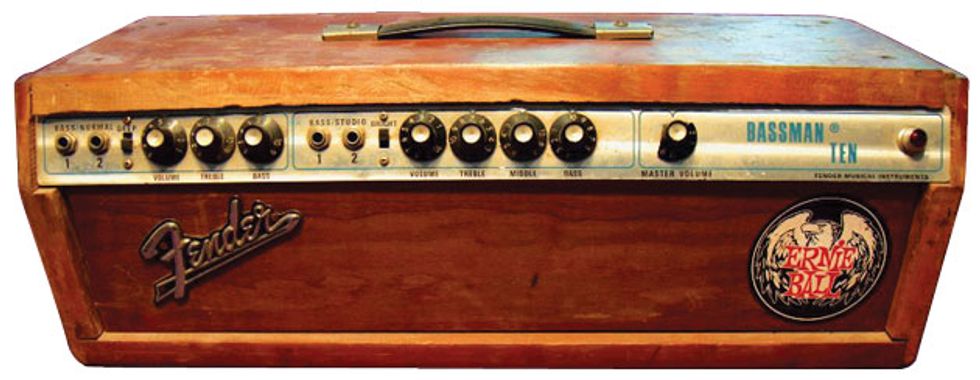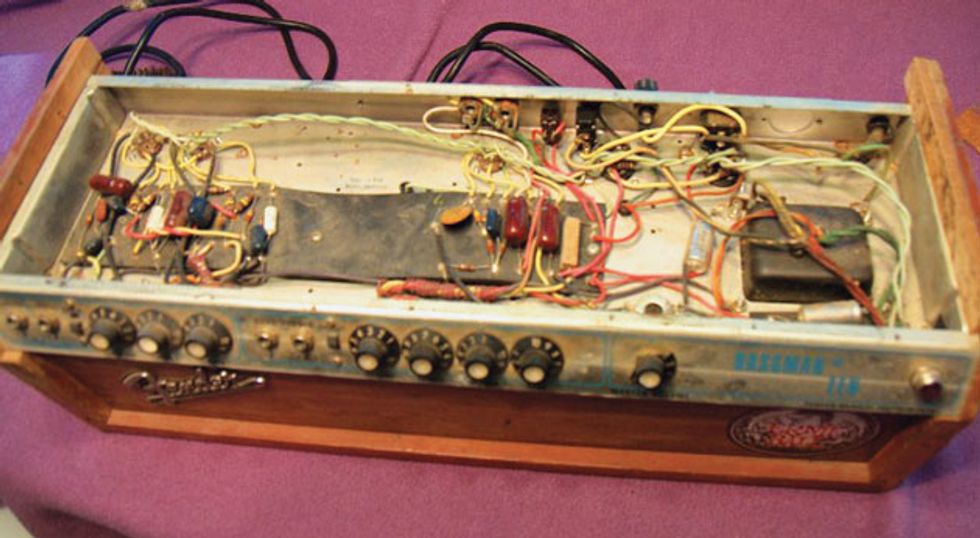Jeff,
I have an oddball amp—and a few questions.
My amp is the amplifier section of an early-’70s Bassman in a homemade head box. The amp has the expected power-supply caps in need of repair, and one of the tubes exhibits some blue glow and an occasional pop. I pulled the power tubes to replace them. All the schematics call for two 6L6GC power tubes, but there are KT66s in my amp. Now I wonder if the amp has been modified. (The schematic, as I’m sure you know, calls for two 7025s, one 12AT7, and two 6L6GCs.)
My questions:
1. Are 6L6s and KT66s swappable?
2. Are circuit changes required to run the KT66 tubes?
3. Are 7025s and 12AX7s interchangeable?
In the studio/bright setting my Guild Bluesbird sounds just fine, so I wonder whether tone-stack modifications were done. Can you point me to a good source of information on this subject?
Curtis L. Putnam
Hello Curtis,
Thanks for your question. While the amp itself is not much of an “oddball,” I always enjoy seeing the creativity and craftsmanship (or lack thereof) that people put into alternative enclosures. Sometimes a combo chassis finds itself mounted in a head shell so it can be used with an assortment of speakers, and occasionally a head chassis gets turned into a one-off combo. Either is fine—it boils down to what best suits your needs.
Now, let’s talk about those tubes, and I will attempt to be your good source of information on this subject. As you mentioned, your tube layout calls for two 7025s, one 12AT7, and two 6L6GCs. This is typical of the ’70s silverface Bassman Ten combo. This differs from typical blackface and silverface Bassman heads, which have one more preamp tube, for a total of four. (There’s actually another triode stage in the bass channel of those amps. Since there are two triodes in each preamp tube, this leaves one unused, which opens up some cool modification possibilities—but that’s for another column.)
Your KT66 output tubes are fine replacements for the 6L6s. The KT66 is, for all practical concerns, the European equivalent of the American 6L6, and in most cases the two are interchangeable. KT66s were the tube of choice for early Marshall amps, and circuit-wise, the original JTM45 amps were almost identical to the Fender Bassman. But since the American 6L6 tubes used in the Bassman were more costly in the UK, Marshall used the more readily available European KT66. That, along with a few other circuit variations, and history was made.
When installing KT66s in an amp that was originally set up with a 6L6 output stage, you may need a bias adjustment, but generally the bias circuit needs no modification since the two tubes share similar bias-voltage requirements. Also, no tube socket rewiring is necessary. One possible limitation, though, is the proximity of the tube sockets, as KT66s tend to be much larger than 6L6s. I find the KT66 to be a bit more “glassy” or “shimmery” on the top end, in a very pleasing way. They also tend to compress a bit more, making it a very fun tube to play, at least for guitar. If you want to use your Bassman for bass, though, you might consider using the stock 6L6 tubes, as they are a bit tighter and less compressed and will probably give you a few more watts of output.
You also asked whether a 12AX7 and 7025 are interchangeable. Again, the answer is yes. The 7025 specified by Fender in the early days actually was a 12AX7 with a lower noise floor and perhaps fewer microphonics. (I don’t know whether this was due to production or selection.) These were typically called for in the first preamp-tube position of each channel and in the reverb recovery section of reverb amps. Since there isn’t a substantial amount of gain/overdrive in either of these circuits, the tube’s noise floor is not a huge issue, and most 12AX7s generally work fine.
Be aware, though, that even if a preamp tube is new, there’s a chance it may be noisy or microphonic. If you want to be sure you’re installing a tube without noise issues in the first gain stage of an amp (and this is especially important in high-gain amps), lean toward tubes that are offered as “low noise,” “low microphonics,” or “selected.” It may be worth the extra couple of bucks.
I hope this clears up your tube mystery. Now you can feel confident in turning up your Bassman Ten to 11!








![Rig Rundown: Russian Circles’ Mike Sullivan [2025]](https://www.premierguitar.com/media-library/youtube.jpg?id=62303631&width=1245&height=700&quality=70&coordinates=0%2C0%2C0%2C0)

















